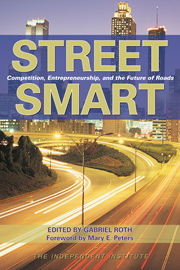Long Beach Press-Telegram, St. Paul Pioneer Press, Tribune-Democrat (PA), Danville News (PA), Hour (CT), Mobile Press Register, Columbian, Fredericks News Post, Bulletin (OR), Gainesville Sun, Lansing State Journal
--------
According to the Texas Transportation Institute’s recently released Urban Mobility Report, road congestion now causes U.S. commuters to spend on average an extra work week every year just sitting in their cars.
In cities large and small and in between, everybody complains about the traffic, as cars clog up crowded roadways. Billions of dollars continue to be spent on transit subsidies, consultants, studies, special commuter lanes, new technologies, and other hoped-for panaceas, but the congestion, delays and road rage continue.
Is there no solution? Are we doomed to spend a good part of our lives stuck in traffic, just going to our jobs and getting home at night?
The bad news is: There’s no perfect solution. Too many people wanting to drive cars on the same roads at the same times of day will always cause problems.
But as some of the country’s leading experts explain in The Independent Institute book Street Smart: Competition, Entrepreneurship, and the Future of Roads, there are ways to ease these problems. Most U.S. road systems are like relics of the former Soviet Union: socialist enterprises run by well-intentioned planners with no regard to the pricing and investment criteria that allocate goods and services in free societies. Moscow citizens got relief from food lines by abolishing socialism. The market economy could similarly liberate road users from excessive congestion.
If we recognize “road space” as a scarce resource, charge market prices for this resource, and use the revenues to stimulate investment in new capacity—such as additional lanes or new technologies to speed traffic past bottlenecks—congestion could be reduced.
Road pricing is not rocket science. Thanks to recent advances in technology, road users can be charged electronically without having to stop their vehicles, and charges can be varied from place to place and time to time as traffic conditions change. This has been done since 1995 on a 10-mile stretch of express toll lanes built in the median of 91 Freeway where the charges are set to ensure free flow at all times and vary from $1.20 at night to $9.50 at the busiest times.
Getting the prices right, however, is not enough. We need to use prices not only to restrain demand but to stimulate and finance needed investment. Unfortunately, some public officials and environmental activists embrace road pricing only to the extent that it will restrain demand. They like the revenues, but want government to spend the money on other things, particularly public transportation.
London’s Mayor Ken Livingstone, for example, introduced “congestion pricing” in London in 2003, but surplus revenues are being spent on mass transit. New York Mayor Michael Bloomberg advocates a similar scheme.
But just as sensible people do not encourage alcoholics to run liquor stores, the insatiable thirst of governments for money should limit their involvement with road-use funds. Realizing this, the Swedish government plans to use surplus revenues from Stockholm’s congestion pricing roadways for highway improvements.
Many criticize road pricing and the private financing and management of roads as unfair to the poor, but market pricing can help everyone. The 91 Freeway express toll lanes are used and favored by all income groups, as they allow rich and poor alike to keep urgent deadlines, such as getting to work on time or picking up a child from day care.
Furthermore, if the market is allowed to work, profits will attract investors willing to spend their own money to expand the road system, permanently reducing congestion and improving conditions for everyone.








